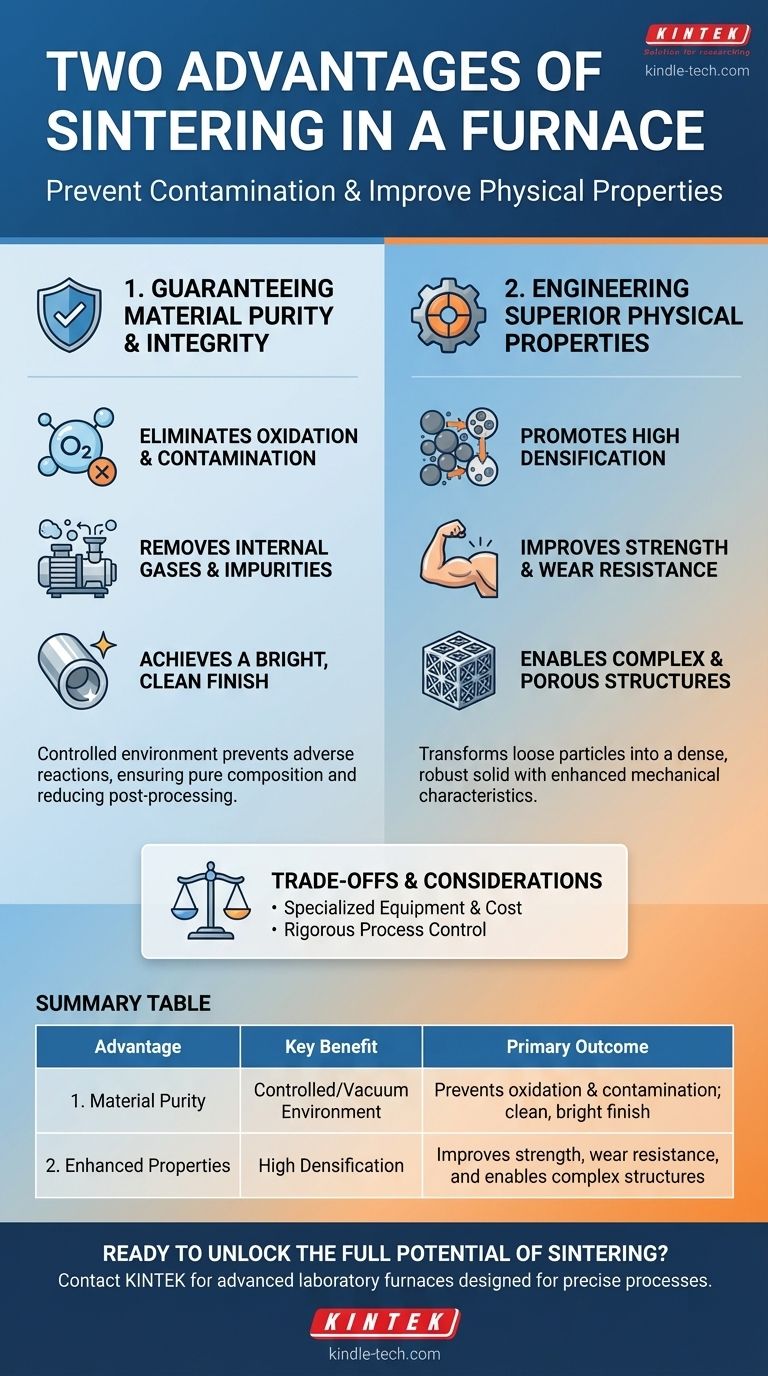In short, the two primary advantages of using a sintering process in a furnace are the prevention of contamination and the significant improvement of the final product's physical properties, such as its strength and density. This controlled environment transforms loose or porous materials into a solid, high-performance final part.
Sintering is not merely a heating process; it is a precise engineering technique. It uses a controlled furnace environment to eliminate impurities and fuse material powders together, creating a dense, robust final product with superior mechanical characteristics.

Advantage 1: Guaranteeing Material Purity and Integrity
The most fundamental advantage of modern sintering furnaces, particularly vacuum furnaces, is the ability to create an ultra-clean environment. This protects the material from a host of chemical reactions that would degrade its quality.
Eliminating Oxidation and Contamination
Many advanced materials, especially metals and certain ceramics, readily react with oxygen and other atmospheric gases at high temperatures.
A controlled or vacuum furnace environment removes these reactive gases. This prevents oxidation and other forms of contamination, ensuring the material's chemical composition remains pure.
Removing Internal Gases and Impurities
The vacuum environment actively pulls harmful substances like trapped gases (oxygen, nitrogen) and moisture out from within the material's pores.
This purification process prevents adverse internal reactions like decarburization or nitriding, leading to a more stable and predictable final product.
Achieving a Bright, Clean Finish
By preventing surface reactions, the sintering process results in parts that are bright and clean right out of the furnace. This often reduces the need for secondary cleaning or finishing steps, saving time and resources.
Advantage 2: Engineering Superior Physical Properties
The second major advantage is the ability to fundamentally re-engineer the material's physical structure. The goal is to transform a collection of particles into a dense, unified solid with enhanced capabilities.
Promoting High Densification
Sintering applies heat and, in some cases, pressure to encourage material particles to bond at an atomic level, eliminating the voids or pores between them.
This process of densification is critical for creating a solid part with minimal internal imperfections, which is the foundation for improved mechanical strength.
Improving Strength and Wear Resistance
A denser, purer material with fewer internal voids is inherently stronger.
Parts produced through sintering exhibit higher strength and superior wear resistance compared to their non-sintered counterparts, making them suitable for demanding mechanical applications.
Enabling Complex and Porous Structures
Specialized sintering techniques, like hot press sintering, allow for the creation of not only dense materials but also parts with complex and intentionally porous structures. This design flexibility is essential for applications like filters or biomedical implants.
Understanding the Trade-offs
While the benefits are significant, it's important to recognize the context. Sintering requires a precise and controlled process, which introduces its own considerations.
Specialized Equipment and Cost
Sintering furnaces, especially those that operate under a high vacuum or with high pressure, are sophisticated pieces of equipment. They represent a significant investment in capital, energy, and operational expertise.
Process Control is Critical
The final properties of the sintered part are highly dependent on factors like temperature, pressure, and the furnace atmosphere. Achieving consistent, high-quality results demands rigorous process control and a deep understanding of the specific material being processed.
Making the Right Choice for Your Goal
The specific advantages of sintering you prioritize will depend entirely on your end goal.
- If your primary focus is creating high-purity components: The key advantage is the furnace's ability to provide a clean, controlled environment that prevents oxidation and contamination.
- If your primary focus is developing strong, durable mechanical parts: The key advantage is the process's power to achieve high densification, directly improving strength and wear resistance.
- If your primary focus is production efficiency: The key advantage is the potential for shorter cycle times and a clean final product that requires fewer post-processing steps.
Ultimately, sintering provides a powerful method for engineering materials with properties that are often impossible to achieve through simple melting and casting.
Summary Table:
| Advantage | Key Benefit | Primary Outcome |
|---|---|---|
| 1. Material Purity | Controlled/Vacuum Environment | Prevents oxidation & contamination; clean, bright finish |
| 2. Enhanced Properties | High Densification | Improves strength, wear resistance, and enables complex structures |
Ready to unlock the full potential of sintering for your materials?
At KINTEK, we specialize in providing advanced laboratory furnaces and consumables designed for precise sintering processes. Whether your goal is achieving ultimate material purity, developing stronger mechanical parts, or improving production efficiency, our solutions deliver the controlled environment and performance you need.
Let KINTEK be your partner in precision. Contact our experts today to discuss how our sintering equipment can enhance your lab's capabilities and drive your research and production forward.
Visual Guide

Related Products
- Vacuum Heat Treat and Molybdenum Wire Sintering Furnace for Vacuum Sintering
- Vacuum Heat Treat and Sintering Furnace with 9MPa Air Pressure
- Dental Porcelain Zirconia Sintering Ceramic Furnace Chairside with Transformer
- Laboratory Quartz Tube Furnace Tubular RTP Heating Furnace
- Spark Plasma Sintering Furnace SPS Furnace
People Also Ask
- What is vacuum sintering? Achieve Unmatched Purity and Performance for Advanced Materials
- What is the standard thickness of plating? Optimize Durability, Corrosion & Cost
- Why is sintering easier in the presence of a liquid phase? Unlock Faster, Lower-Temperature Densification
- Does sintering use diffusion? The Atomic Mechanism for Building Stronger Materials
- Where is vacuum furnace used? Essential for Aerospace, Medical, and High-Tech Manufacturing



















